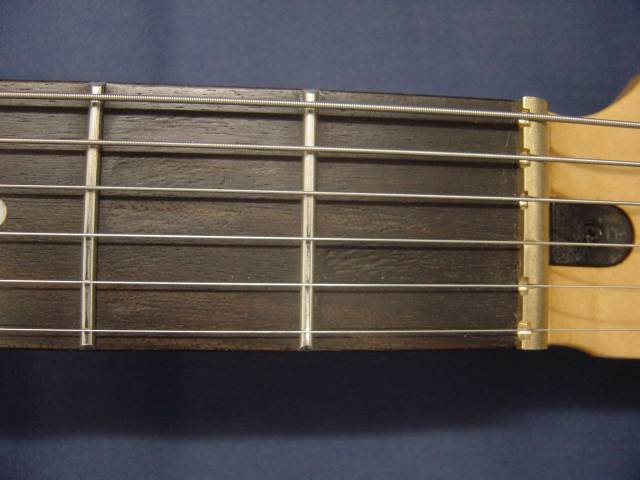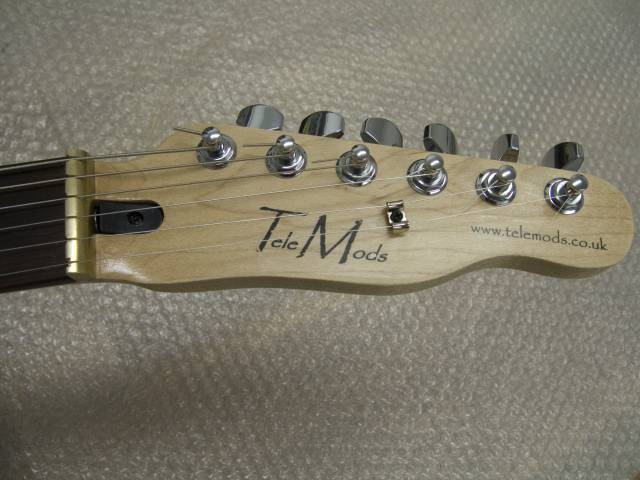 |
 |
| Home | For Sale | Gallery | Other Mods | Setup / Repairs | Feedback | Contact / Links | TSGC |
Repairs / Setups
Fretboard work
Yamaha Pacifica Telecasters, apart from the Mike Stern Signature model (PAC 1511MS), have a fingerboard radius of 13.75 inches (350mm). This is quite 'flat' compared with many other guitar manufacturers' necks (eg Fender Telecaster - 7.5 or 9.5 inches) and makes the guitar suitable for lead work (where string bends don't choke out as easily) and for rhythm / chording.
In order to get a low playing action, without any buzzing, the frets need to be very 'level' so that adjacent frets don't affect one another. To achieve this, we remove the neck and then adjust the truss-rod until the fingerboard is perfectly 'flat' (neither concave nor convex) and then 'level' the frets with a purpose made sanding block of the correct radius. When the frets are all level to within 1 thou they can be 'dressed' using a fret-crowning file and a fret-end file before finally 'polishing' them to a high shine using wire wool.
Neck work
 While the neck is removed, we take the opportunity to fit threaded inserts into the existing neck-heel holes. This makes a big difference to the sustain of the instrument and gives us more confidence to remove the neck as many times as we need without the fear of stripping the threads in the wood each time we re-assemble. This 'ease of neck removal' can also be of great benefit to travelling musicians who can dismantle the guitar for packing as 'hand luggage' on flights.
While the neck is removed, we take the opportunity to fit threaded inserts into the existing neck-heel holes. This makes a big difference to the sustain of the instrument and gives us more confidence to remove the neck as many times as we need without the fear of stripping the threads in the wood each time we re-assemble. This 'ease of neck removal' can also be of great benefit to travelling musicians who can dismantle the guitar for packing as 'hand luggage' on flights.
Nut work
There's much discussion taking place, at the moment, about 'compensated nuts'. Several highly respected guitar manufacturers (eg Tom Anderson and Washburn) are already fitting the Buzz Feiten system as standard to all their new guitars. Retrofitting a Buzz Feiten compensated nut can only, at present, be carried out by a Buzz Feiten approved luthier.
However, the Earvana compensated nut system can be installed by anyone.
Both these systems utilise the 'shelf nut' idea whereby the fingerboard is not altered by the fitting of the compensated nut. So, if you don't like it, you can put your old nut back in. However, I'm so confident that the Earvana system works that I've 'shaved' around 1mm off the fingerboard end in order to fit a brass copy of the Earvana shelf nut (but without the 'shelf').
 Headstock work
Headstock work
Telecasters are generally pretty good at keeping in tune because there's no tremolo to cause havoc with the string tension. However, in order to improve things even further, we replace the standard Yamaha tuners with locking tuners such as Sperzels or similar giving the guitars 'rock steady' tuning. We re-shape the ugly Yamaha headstock to look more like the Fender version and apply a 'TeleMods' decal in an effort to 'spread the word'.
Bridge work
Yamaha Pacifica Telecaster bridges comprise of 6 individually adjustable steel saddles with both a 'back and forth' adjustment screw as well as 2 'height' ajustment 'grub' screws on each saddle. These 'grub' screws are often too long and protrude above the top of the saddle when the bridge is properly adjusted. This makes the bridge very uncomfortable when resting the hand on it - especially when 'palm-damping'. We replace these screws with smaller ones to eliminate the problem.